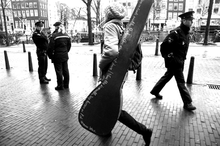Legality of recording by civilians
The laws regarding the recording of other persons and property by means of still photography, videography, and audio recording vary by location. In many places, it is common for the recording of public property, persons within the public domain, and of private property visible or audible from the public domain to be legal. But laws have been passed in many places restricting such activity in order to protect the privacy of others. To make matters even more complicated, in many places and in many situations, the laws governing still photography may be vastly different from the laws governing any type of motion picture photography.
In the United States, anti-photography laws have been passed in many places following the September 11, 2001 attacks and the increased popularity of camera phones. There might be local laws and policies governing the specific landmark or property on which one seeks to photograph. Laws on private property differ. Owners of private property in most places must authorize recording on their own property.
Exceptions

High-profile locations
In the United States, the filming of many high-profile locations that are feared to be targets of possible terrorist attacks is restricted. For example, signs posted around many bridges, including the Verrazano-Narrows Bridge, state that filming the structure is prohibited. The legality of such restrictions is problematic; in view of the First Amendment, restrictions on taking pictures of a public structure in public may be unconstitutional, (in view of the fact that prohibiting taking pictures will probably neither prevent nor reduce the potential for such attacks, nor do such prohibitions necessarily mean it will in any way hinder someone from committing an attack in the first place.) The courts have held, however, that in some cases, restrictions on taking pictures on military reservations such as military bases, can be constitutionally valid, so a restriction on taking a picture of a structure that is operated by the military or is on a military reservation might be constitutional, but even then, such restrictions must be reasonable and have some relevant purpose. Forbidding pictures of a weapons system on a military base would have relevance to preventing enemy acquisition of technology and would be such a legitimate purpose, but the mere forbidding of taking pictures of a latrine, a post exchange (PX) or a mess hall probably would not (especially if the purpose was to publicize military ineptitude or incompetence, such as the lax state of the restroom's cleanliness, bad or overpriced merchandise, or the food were horrible.)
In August 2004, an Annandale, Virginia, man was arrested and detained when his wife was observed by a police officer filming the Chesapeake Bay Bridge as he drove across.[1] He was held as a material witness after he was found to have ties to Hamas.[2] He was later released on bail without being charged.
Voyeurism
Many places have passed or considered legislation that prohibits voyeurism with phones and other similar devices, commonly referred to as "upskirting" or "downblousing."[3][4][5] Such behaviors have become common since camera phones have become popular, thereby raising such concerns. On March 7th, 2014, Massachusetts Supreme Judicial Court hearing ruled that taking photos of someone up their skirt was not specifically prevented by peeping tom laws. The Massachusetts Supreme Court Judges concluded that since the current laws didn't make any distinction for clothed individuals, only for 'partially or completely' undressed ones, it was legal under current Massachusetts law.[6][7] The very next day, legislation was introduced to ban upskirting in its entirety. It soon received bipartisan support and was approved and enacted on March 8th, 2014.[8]
Public display
Laws prohibiting the photography of citizens for public display have delayed the release of Google Street View in some countries in Europe.[9]
Voice recording
Laws differ in the United States on how many parties must give their consent before a conversation may be recorded. In 38 states and the District of Columbia, conversations may be recorded if the person is party to the conversation, or if at least one of the people who are party to the conversation have given a third party consent to record the conversation. In California, Connecticut, Delaware, Florida, Illinois, Maryland, Massachusetts, Nevada, New Hampshire, Pennsylvania, Vermont, and Washington State, the consent of all parties of the conversation must be obtained in order to record a conversation.[10] (However, the law changes rapidly and any links may be soon out of date. Consult a lawyer for accurate, current advice)
In Canada, telephone calls may be recorded without court order if one of the parties to the call consents to the recording. It is to a judge's discretion as to whether or not to admit the recording into evidence if both parties are not aware of the conversation having been recorded.
See also
- Worldwide Photographer's Rights : Free ebook on privacy laws in many countries in regard to street photography.
- Photography and the law
- Street photography
- Sousveillance (inverse surveillance)
References
- ↑ Markon, Jerry; Rich, Eric (2004-08-26). "Va. Family Defends Video of Bay Bridge". The Washington Post. Retrieved 2010-05-07.
- ↑ Rich, Eric; Markon, Jerry (2004-08-25). "Va. Man Tied to Hamas Held as Witness". The Washington Post. Retrieved 2010-05-07.
- ↑ "Md. Delegate Wants 'Upskirt' Photos Banned - WTOP.com". Wtopnews.com. 2010-05-25. Retrieved 2013-03-14.
- ↑ "'Upskirt' Photo Ban Sought". Fox News. 2005-11-14.
- ↑ "Upskirting to become a crime". The Sydney Morning Herald. 2006-07-28.
- ↑ Quinn, Garrett. "Massachusetts Supreme Judicial Court: Upskirt photos not illegal under state law". Retrieved 22 March 2014.
- ↑ Horn, Leslie. "Upskirts Are Totally Legal, Says Bad and Gross MA Court Ruling". Retrieved 22 March 2014.
- ↑ Ravitz, Jessica. "'Upskirt' ban in Massachusetts signed into law". Retrieved 22 March 2014.
- ↑ "Google's Street View could be unlawful in Europe". Out-law.com. Retrieved 2013-03-14.
- ↑ "Summary of Consent Requirements for Taping Telephone Conversations". Association of American Physicians and Surgeons. Retrieved 13 February 2010.